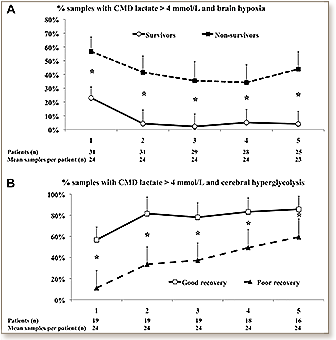 Background and Purpose-Lactate is central for the regulation of brain metabolism and is an alternative substrate to glucose after injury. Brain lactate metabolism in patients with subarachnoid hemorrhage has not been fully elucidated. Methods-Thirty-one subarachnoid hemorrhage patients monitored with cerebral microdialysis (CMD) and brain oxygen (PbtO2) were studied. Samples with elevated CMD lactate (>4 mmol/L) were matched to PbtO2 and CMD pyruvate and categorized as hypoxic (PbtO2 <20 mm Hg) versus nonhypoxic and hyperglycolytic (CMD pyruvate >119 μmol/L) versus nonhyperglycolytic. Results-Median per patient samples with elevated CMD lactate was 54% (interquartile range, 11%-80%). Lactate elevations were more often attributable to cerebral hyperglycolysis (78%; interquartile range, 5%-98%) than brain hypoxia (11%; interquartile range, 4%-75%). Mortality was associated with increased percentage of samples with elevated lactate and brain hypoxia (28% [interquartile range 9%-95%] in nonsurvivors versus 9% [interquartile range 3%-17%] in survivors; P=0.02) and lower percentage of elevated lactate and cerebral hyperglycolysis (13% [interquartile range, 1%-87%] versus 88% [interquartile range, 27%-99%]; P=0.07). Cerebral hyperglycolytic lactate production predicted good 6-month outcome (odds ratio for modified Rankin Scale score, 0-3 1.49; CI, 1.08-2.05; P=0.016), whereas increased lactate with brain hypoxia was associated with a reduced likelihood of good outcome (OR, 0.78; CI, 0.59-1.03; P=0.08). Conclusions-Brain lactate is frequently elevated in subarachnoid hemorrhage patients, predominantly because of hyperglycolysis rather than hypoxia. A pattern of increased cerebral hyperglycolytic lactate was associated with good long-term recovery. Our data suggest that lactate may be used as an aerobic substrate by the injured human brain.
Background and Purpose-Lactate is central for the regulation of brain metabolism and is an alternative substrate to glucose after injury. Brain lactate metabolism in patients with subarachnoid hemorrhage has not been fully elucidated. Methods-Thirty-one subarachnoid hemorrhage patients monitored with cerebral microdialysis (CMD) and brain oxygen (PbtO2) were studied. Samples with elevated CMD lactate (>4 mmol/L) were matched to PbtO2 and CMD pyruvate and categorized as hypoxic (PbtO2 <20 mm Hg) versus nonhypoxic and hyperglycolytic (CMD pyruvate >119 μmol/L) versus nonhyperglycolytic. Results-Median per patient samples with elevated CMD lactate was 54% (interquartile range, 11%-80%). Lactate elevations were more often attributable to cerebral hyperglycolysis (78%; interquartile range, 5%-98%) than brain hypoxia (11%; interquartile range, 4%-75%). Mortality was associated with increased percentage of samples with elevated lactate and brain hypoxia (28% [interquartile range 9%-95%] in nonsurvivors versus 9% [interquartile range 3%-17%] in survivors; P=0.02) and lower percentage of elevated lactate and cerebral hyperglycolysis (13% [interquartile range, 1%-87%] versus 88% [interquartile range, 27%-99%]; P=0.07). Cerebral hyperglycolytic lactate production predicted good 6-month outcome (odds ratio for modified Rankin Scale score, 0-3 1.49; CI, 1.08-2.05; P=0.016), whereas increased lactate with brain hypoxia was associated with a reduced likelihood of good outcome (OR, 0.78; CI, 0.59-1.03; P=0.08). Conclusions-Brain lactate is frequently elevated in subarachnoid hemorrhage patients, predominantly because of hyperglycolysis rather than hypoxia. A pattern of increased cerebral hyperglycolytic lactate was associated with good long-term recovery. Our data suggest that lactate may be used as an aerobic substrate by the injured human brain.